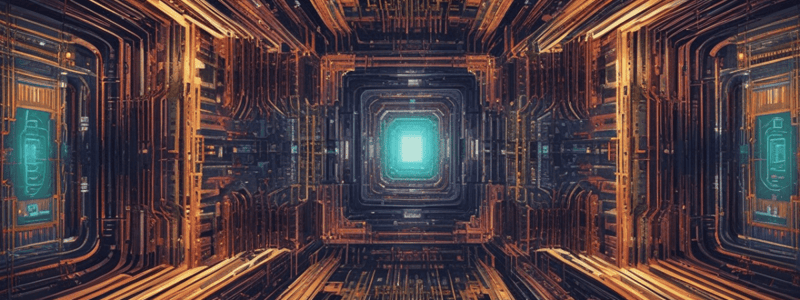Podcast
Questions and Answers
What type of multiprocessors share a single centralized memory where processors have equal access to?
What type of multiprocessors share a single centralized memory where processors have equal access to?
- Symmetric (shared-memory) multiprocessors - SMP (correct)
- Multicomputers
- Distributed Shared Memory (DSM) multiprocessors
- Nonuniform Memory Access (NUMA) multiprocessors
What is a characteristic of Symmetric Multiprocessors (SMP) in terms of access time to memory?
What is a characteristic of Symmetric Multiprocessors (SMP) in terms of access time to memory?
- Distributed Memory Access
- Nonuniform Memory Access (NUMA)
- Separate Memory Access
- Uniform Memory Access (UMA) (correct)
What is a potential bottleneck in Symmetric Multiprocessors (SMP)?
What is a potential bottleneck in Symmetric Multiprocessors (SMP)?
- Network bandwidth
- Memory/bus (correct)
- Cache size
- Number of processors
What type of multiprocessors do not share a single centralized memory?
What type of multiprocessors do not share a single centralized memory?
What is the typical number of cores in a Symmetric Multiprocessor (SMP)?
What is the typical number of cores in a Symmetric Multiprocessor (SMP)?
What is an alternative to Symmetric Multiprocessors (SMP)?
What is an alternative to Symmetric Multiprocessors (SMP)?
What type of architecture is characterized by multiple instruction streams and multiple data streams?
What type of architecture is characterized by multiple instruction streams and multiple data streams?
Which type of computer consists of tightly coupled processors whose coordination/usage are generally controlled by a single OS and that share memory through a shared address space?
Which type of computer consists of tightly coupled processors whose coordination/usage are generally controlled by a single OS and that share memory through a shared address space?
What type of memory access is characterized by a single memory space that is shared by all processors?
What type of memory access is characterized by a single memory space that is shared by all processors?
What type of system is characterized by multiple processors that are not shared by a single memory space?
What type of system is characterized by multiple processors that are not shared by a single memory space?
What is a characteristic of Symmetric Multiprocessors (SMP)?
What is a characteristic of Symmetric Multiprocessors (SMP)?
What type of memory access is characterized by different access times for different memory locations?
What type of memory access is characterized by different access times for different memory locations?
What type of system is characterized by a collection of processors that are connected using a network and do not share a common memory space?
What type of system is characterized by a collection of processors that are connected using a network and do not share a common memory space?
What is a key challenge in designing Symmetric Multiprocessors (SMP)?
What is a key challenge in designing Symmetric Multiprocessors (SMP)?
What is the main advantage of Distributed Shared Memory (DSM) architecture in terms of memory bandwidth?
What is the main advantage of Distributed Shared Memory (DSM) architecture in terms of memory bandwidth?
Which of the following is a characteristic of Symmetric Multiprocessors (SMP)?
Which of the following is a characteristic of Symmetric Multiprocessors (SMP)?
What is the main difference between Symmetric Multiprocessors (SMP) and Distributed Shared Memory (DSM)?
What is the main difference between Symmetric Multiprocessors (SMP) and Distributed Shared Memory (DSM)?
Which of the following communication models is typically used in Distributed Shared Memory (DSM) architecture?
Which of the following communication models is typically used in Distributed Shared Memory (DSM) architecture?
What is the characteristic of Nonuniform Memory Access (NUMA) architecture?
What is the characteristic of Nonuniform Memory Access (NUMA) architecture?
Which of the following is a characteristic of Multicomputers?
Which of the following is a characteristic of Multicomputers?
What is the market share characteristic of Symmetric Multiprocessors (SMP)?
What is the market share characteristic of Symmetric Multiprocessors (SMP)?
Which of the following is an advantage of Symmetric Multiprocessors (SMP)?
Which of the following is an advantage of Symmetric Multiprocessors (SMP)?
What is the role of caches in Symmetric Multiprocessors (SMP)?
What is the role of caches in Symmetric Multiprocessors (SMP)?
Which of the following communication models can also be applied to Distributed Shared Memory (DSM)?
Which of the following communication models can also be applied to Distributed Shared Memory (DSM)?
Study Notes
Memory Organization
- Multiprocessors classified by their memory organization
- Symmetric (shared-memory) multiprocessors - SMP:
- 32 cores or less
- Single centralized memory with equal access for processors
- Uniform access time - UMA to all memory
- May have memory/bus bottleneck
- Use of large caches and many buses
- Distributed shared memory - DSM:
- 16-64 processor cores
- Distributed memory to increase bandwidth and reduce access latency
- Communicating data among processors is more complex
- Requires more software effort to take advantage of increased memory bandwidth
- Nonuniform memory access - NUMA
- Each node can be a small distributed system with centralized memory
SMP Architecture
- Processors share a single memory
- Uniform access times to the memory
- Suitable for systems with a small number of processors
DSM Architecture
- Processors share the same address space
- Not necessarily the same physical memory
- Suitable for systems with a large number of processors
Multicomputers
- Processors with independent memories and address spaces
- Communicate through interconnection networks
- May even be complete computers connected in a network (clusters)
Communication Models
- SMP: central memory, threads and fork-join model, open multi-processing - OpenMP, implicit communication (memory access)
- DSM: distributed memory, message passing model, message passing interface - MPI, explicit communication (message passing), synchronization problems
Market Share
- SMP: bigger market share in terms of dollars and units, multiprocessors in a chip
- Multicomputers: popularization of clusters for systems on the internet, massively parallel processors - MPP
SMP Advantages
- Large and efficient cache systems can reduce the need for memory bandwidth
- Provide some cost benefits as they need not much extra hardware, and are based on general-purpose processors - GPP
- Caches provide not only locality but also replication
Studying That Suits You
Use AI to generate personalized quizzes and flashcards to suit your learning preferences.
Related Documents
Description
This quiz covers the basics of computer architecture, focusing on memory organization and multiprocessors. It discusses different types of multiprocessors, such as symmetric and distributed memory multiprocessors.




